Driving in Spain: the 10 questions everyone gets wrong on their theory test in 2022

Getting your driving licence in Spain is challenging enough as it is, let alone if you’re a foreigner who isn’t fluent in Spanish. To help you pass, we’ve put together the questions that most people got wrong in their theory test in Spain in 2022.
In order to pass your theory test in Spain, you will have to answer 30 questions and if you get more than three answers wrong you will not pass and have to sit it again.
While the option of taking the DGT’s theory exam (examen teórico) in English is available, some English speakers in Spain have said that the translations aren’t always spot on and can be confusing.
It’s true that written Spanish can be more long-winded than English, but if you’re getting your driving licence in Spain it probably means you’re settling here, so learning the right Spanish driving vocab, and Spanish in general is probably the right way to go.
The wording of questions and potential answers in Spain’s theory test is often complex and can be misleading even for native speakers.
READ ALSO:
- Q&A: How to pass Spain’s driving test and get a Spanish licence
- Spanish driving licence: the essential language to pass your practical test
- Driving in Spain: Can I take my practical exam in English?
The following are the questions that most people who sat their theory test in Spain in 2022 got wrong, according to driving consultancy firm PONS Seguridad Vial, who reviewed information from 2,300 driving schools.
We've included the questions and answers in Spanish, their English translation and an explanation as to why many people get it wrong.
They may not necessarily help you become a better driver, but knowing which questions to watch out for may well help you pass. Here goes!
1. Esta señal
A) Indica una vía reservada exclusivamente para ciclos.
B) Indica una vía reservada para peatones y ciclos.
C) Prohíbe a las bicicletas circular por la vía.
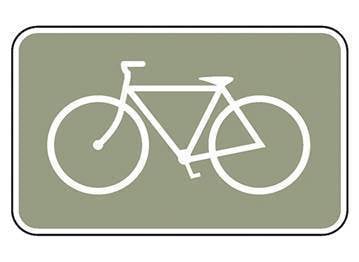
(Translation) What does this road sign indicate?
A) Indicates a path reserved exclusively for bicycles.
B) Indicates a path reserved for pedestrians and bicycles. (correct answer)
C) It prohibits bicycles from circulating on the road.
Explanation: This sign indicates the existence of a path for pedestrians and cycles, separate from normal road traffic, and that runs through open spaces, parks, gardens or forests. The image of the bicycle is slightly misleading, and you shouldn’t confuse it for the circular sign with the blue background and this same white silhouette because this sign is exclusively for cycles.
2. Al salir marcha atrás de un estacionamiento con su vehículo, el cual dispone del sistema de alerta de tráfico cruzado, debe saber que este sistema…
A) Ayudará al conductor esquivando el obstáculo en el mismo momento en que lo detecte.
B) Tomará el control del vehículo deteniéndolo inmediatamente cuando detecte un vehículo aproximándose.
C) Emitirá un aviso sonoro y/o visual cuando detecte un vehículo aproximándose.
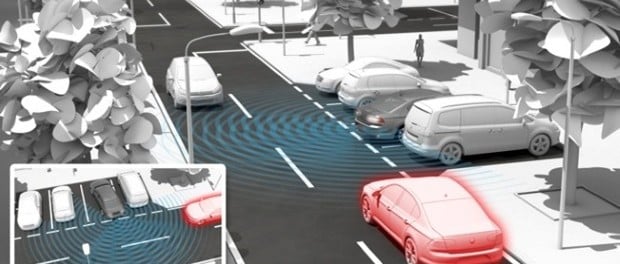
(Translation) When backing out of a parking lot, if your vehicle has the cross traffic alert system, you should know that this system…
A) Will help the driver by avoiding the obstacle the moment it detects it.
B) Will take control of the vehicle by stopping it immediately when it detects an approaching vehicle.
C) Will issue an audible and/or visual warning when it detects an approaching vehicle. (correct answer)
Explanation: Cross Traffic Alert System monitors detect traffic when reversing out a line of parked vehicles. If it detects an approaching vehicle, an audible and/or visual warning will be issued.
3. Un tractor que arrastra un remolque, ¿qué velocidad máxima no debe rebasar fuera de poblado?
A) 25 kilómetros por hora.
B) 40 kilómetros por hora.
C) 70 kilómetros por hora.
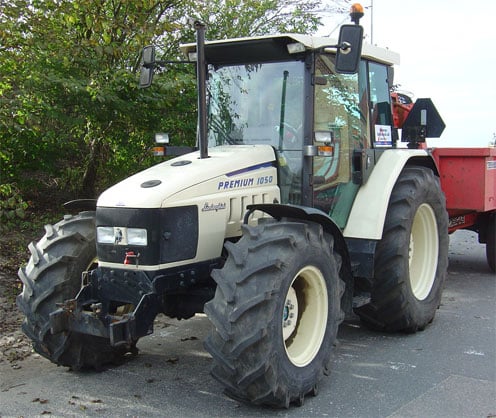 Photo: Mangan2002/Wikipedia
Photo: Mangan2002/Wikipedia
(Translation) What maximum speed can a tractor pulling a trailer not exceed outside urban areas?
A) 25 kilometres per hour (correct answer)
B) 40 kilometres per hour.
C) 70 kilometres per hour.
Explanation: Vehicles that are deemed ‘especiales’ in Spain (tractors and other vehicles used for building and agricultural purposes, as well as vehicles with an attachment or trailer).
With B licences, special agricultural vehicles can be driven. The maximum speed of these vehicles as a general rule is 40 km/h but this is reduced to 25 km/h when they are towing a trailer as it makes the vehicle more unstable.
4. Si está en posesión del permiso de la clase A1, con un año y medio de antigüedad, y obtiene el permiso B, ¿cuál es la tasa máxima de alcohol permitida conduciendo su turismo?
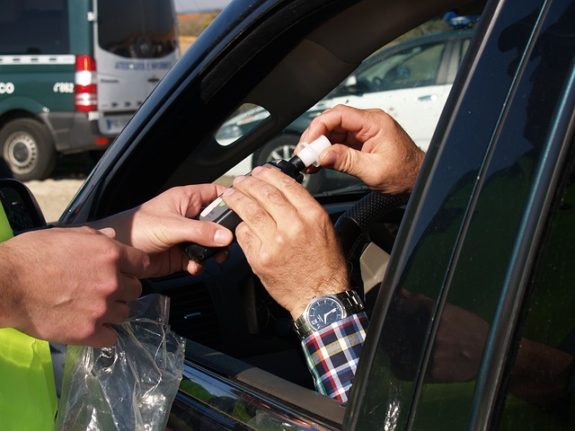
Photo: Miguel Ángel Ramón/Pixabay
A) 0,15 gramos por litro en sangre.
B) 0,30 gramos por litro de sangre.
C) 0,50 gramos por litro en sangre.
(Translation) If you are in possession of the A1 driver’s permit that’s one and a half years old, and you obtain the B permit, what is the maximum blood alcohol level for driving your car?
A) 0.15 grammes per litre of blood.
B) 0.30 grammes per litre of blood. (correct answer)
C) 0.50 grammes per litre of blood.
Explanation: The maximum blood alcohol level for drivers for the two years after obtaining their first driving license is: 0.3 g / l (in blood) and 0.15 mg / l (breathalyser). Whereas learner drivers have to drive with the L sign in their car for a year, their blood alcohol content limit as learners is applicable for the first two years from obtaining their licence.
5. En una intersección sin señalización expresa, la norma general de preferencia de paso es…
A) Ceder el paso a los vehículos más rápidos, ciclistas y peatones.
B) Ceder el paso a los vehículos que circulen por la izquierda.
C) Ceder el paso a los vehículos que se aproximen por la derecha.
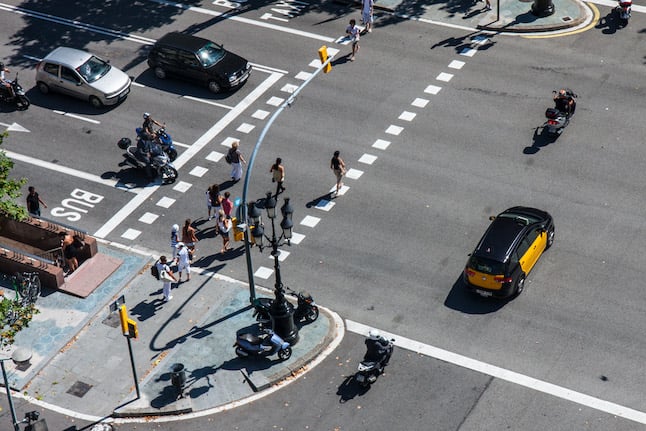
Cars at a junction. Photo: PxHere
(Translation) At an intersection without express signage, the general rule of right-of-way is...
A) Give way to faster vehicles, cyclists and pedestrians.
B) Give way to vehicles driving on the left.
C) Give way to vehicles approaching from the right. (correct answer)
Explanation: At intersections where there is no sign that regulates right-of-way, you are obliged to give way to vehicles approaching from the right. So if there’s a sign, do what the sign says and if there isn’t, give to vehicles approaching from the right.
6. ¿Qué efectos positivos tiene el sistema Start-Stop del vehículo?
A) Reduce las emisiones y el consumo del vehículo.
B) Frena el vehículo antes una señal de stop.
C) Reduce el consumo del vehículo, solamente.
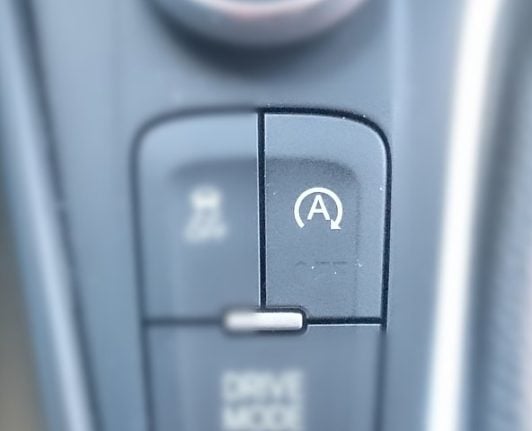 Photo: TheRedBurn/Wikipedia
Photo: TheRedBurn/Wikipedia
(Translation) What positive features does a vehicle's start-stop system have?
A) It reduces emissions and consumption of the vehicle. (correct answer)
B) It brakes the vehicle before a stop sign.
C) It only reduces the consumption of the vehicle.
Explanation: Some vehicles have a start-stop season that reduces emissions by up to 5 percent and consumption by up to 15 percent. Some drivers believe the system stops and starts "too many times" and "causes premature engine deterioration" but this isn't true.
7. ¿Qué debe hacer si el resultado de una inspección ITV es desfavorable?
A) Llevar el vehículo al taller en una grúa obligatoriamente y volver a pasar la inspección en un plazo inferior a dos meses.
B) Llevar el vehículo al taller para repararlo y volver a pasar la inspección en un plazo inferior a un mes.
C) Llevar el vehículo al taller para repararlo y volver a pasar la inspección en un plazo inferior a dos meses.
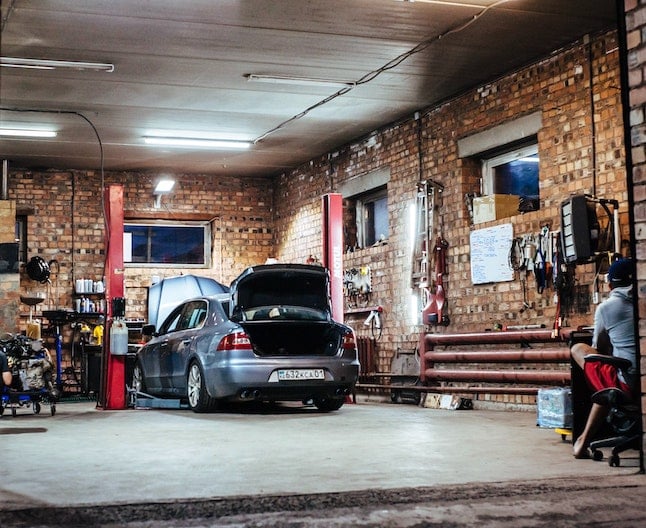
The ITV inspection in Spain is similar to the MOT in the UK. Photo: Damir Kopezhanov / Unsplash
(Translation) What should you do if the result of an ITV inspection is unfavourable?
A) Take the vehicle to a garage in a tow truck to undergo the inspection again within a period of fewer than two months.
B) Take the vehicle to the garage to repair it and undergo the inspection again within a period of less than one month.
C) Take the vehicle to the garage to repair it and undergo the inspection again within a period of fewer than two months. (correct answer)
Explanation: It is not necessary to stop driving your car and get a tow truck to take it to the garage for repair, however, you must do it within fewer than two months, not one month.
8. Generalmente, en las motocicletas el freno trasero se acciona con..
A) el pie derecho.
B) el pie izquierdo.
C) la mano izquierda.

This question on motorcycles often trips people up. Photo: Harley-Davidson / Unsplash
(Translation) Generally, on motorcycles, the rear brake is activated with...
A) The right foot. (correct answer)
B) The left foot.
C) The left hand.
Explanation: If you're not familiar with driving a motorcycle, this question may throw you a bit. Generally, if you want to break on a motorcycle, you will use your right foot. It's important to be aware of other types of vehicles on the road with you.
9. ¿Qué características tiene una bicicleta de pedales con pedaleo asistido?
A) Tiene un motor con potencia no superior a 0,5 kW cuya velocidad se interrumpe antes de alcanzar los 25 km/h o si se deja de pedalear.
B) Es una bicicleta con motor considerada como un ciclomotor de dos ruedas
C) Tiene un motor eléctrico auxiliar de hasta 250 W cuya velocidad se interrumpe antes de alcanzar los 25 km/h o si se deja de pedalear.
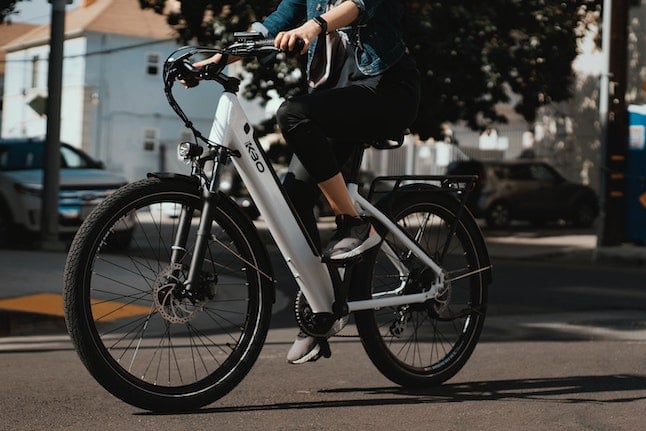
Bike with assisted pedalling. Photo: KBO Bike / Unsplash
(Translation) What characteristics does a pedal bicycle with assisted pedalling have?
A) It has a motor with power not exceeding 0.5 kW whose speed is interrupted before reaching 25 km/h or if pedalling has stopped.
B) It is a motorised bicycle considered to be a two-wheeled moped.
C) It has an auxiliary electric motor of up to 250 W whose speed is interrupted before reaching 25 km/h or if you stop pedalling. (correct answer)
Explanation: Like the question above, drivers may not be familiar with the characteristics of e-bikes, so you must make sure to study other vehicles that may be on the road with you.
10. Además del airbag frontal, ¿existen otros tipos de airbag?
A) No.
B) Sí, los frontales de conductor y acompañante, los laterales de piernas y de techo o cortina.
C) Sí, los laterales.

Where are the airbags located in a car? Photo: Julian Hochgesang / Unsplash
(Translation) Besides the front airbag, are there other types of airbags?
A) No.
B) Yes, the front ones for the driver and passenger, the sides for the legs and the roof or curtain. (correct answer)
C) Yes, the sides.
Explanation: Drivers may not be aware of all the safety features of their cars, so it's important to study and learn exactly what they have.
Comments
See Also
In order to pass your theory test in Spain, you will have to answer 30 questions and if you get more than three answers wrong you will not pass and have to sit it again.
While the option of taking the DGT’s theory exam (examen teórico) in English is available, some English speakers in Spain have said that the translations aren’t always spot on and can be confusing.
It’s true that written Spanish can be more long-winded than English, but if you’re getting your driving licence in Spain it probably means you’re settling here, so learning the right Spanish driving vocab, and Spanish in general is probably the right way to go.
The wording of questions and potential answers in Spain’s theory test is often complex and can be misleading even for native speakers.
READ ALSO:
- Q&A: How to pass Spain’s driving test and get a Spanish licence
- Spanish driving licence: the essential language to pass your practical test
- Driving in Spain: Can I take my practical exam in English?
The following are the questions that most people who sat their theory test in Spain in 2022 got wrong, according to driving consultancy firm PONS Seguridad Vial, who reviewed information from 2,300 driving schools.
We've included the questions and answers in Spanish, their English translation and an explanation as to why many people get it wrong.
They may not necessarily help you become a better driver, but knowing which questions to watch out for may well help you pass. Here goes!
1. Esta señal
A) Indica una vía reservada exclusivamente para ciclos.
B) Indica una vía reservada para peatones y ciclos.
C) Prohíbe a las bicicletas circular por la vía.

(Translation) What does this road sign indicate?
A) Indicates a path reserved exclusively for bicycles.
B) Indicates a path reserved for pedestrians and bicycles. (correct answer)
C) It prohibits bicycles from circulating on the road.
Explanation: This sign indicates the existence of a path for pedestrians and cycles, separate from normal road traffic, and that runs through open spaces, parks, gardens or forests. The image of the bicycle is slightly misleading, and you shouldn’t confuse it for the circular sign with the blue background and this same white silhouette because this sign is exclusively for cycles.
2. Al salir marcha atrás de un estacionamiento con su vehículo, el cual dispone del sistema de alerta de tráfico cruzado, debe saber que este sistema…
A) Ayudará al conductor esquivando el obstáculo en el mismo momento en que lo detecte.
B) Tomará el control del vehículo deteniéndolo inmediatamente cuando detecte un vehículo aproximándose.
C) Emitirá un aviso sonoro y/o visual cuando detecte un vehículo aproximándose.

(Translation) When backing out of a parking lot, if your vehicle has the cross traffic alert system, you should know that this system…
A) Will help the driver by avoiding the obstacle the moment it detects it.
B) Will take control of the vehicle by stopping it immediately when it detects an approaching vehicle.
C) Will issue an audible and/or visual warning when it detects an approaching vehicle. (correct answer)
Explanation: Cross Traffic Alert System monitors detect traffic when reversing out a line of parked vehicles. If it detects an approaching vehicle, an audible and/or visual warning will be issued.
3. Un tractor que arrastra un remolque, ¿qué velocidad máxima no debe rebasar fuera de poblado?
A) 25 kilómetros por hora.
B) 40 kilómetros por hora.
C) 70 kilómetros por hora.
 Photo: Mangan2002/Wikipedia
Photo: Mangan2002/Wikipedia
(Translation) What maximum speed can a tractor pulling a trailer not exceed outside urban areas?
A) 25 kilometres per hour (correct answer)
B) 40 kilometres per hour.
C) 70 kilometres per hour.
Explanation: Vehicles that are deemed ‘especiales’ in Spain (tractors and other vehicles used for building and agricultural purposes, as well as vehicles with an attachment or trailer).
With B licences, special agricultural vehicles can be driven. The maximum speed of these vehicles as a general rule is 40 km/h but this is reduced to 25 km/h when they are towing a trailer as it makes the vehicle more unstable.
4. Si está en posesión del permiso de la clase A1, con un año y medio de antigüedad, y obtiene el permiso B, ¿cuál es la tasa máxima de alcohol permitida conduciendo su turismo?

Photo: Miguel Ángel Ramón/Pixabay
A) 0,15 gramos por litro en sangre.
B) 0,30 gramos por litro de sangre.
C) 0,50 gramos por litro en sangre.
(Translation) If you are in possession of the A1 driver’s permit that’s one and a half years old, and you obtain the B permit, what is the maximum blood alcohol level for driving your car?
A) 0.15 grammes per litre of blood.
B) 0.30 grammes per litre of blood. (correct answer)
C) 0.50 grammes per litre of blood.
Explanation: The maximum blood alcohol level for drivers for the two years after obtaining their first driving license is: 0.3 g / l (in blood) and 0.15 mg / l (breathalyser). Whereas learner drivers have to drive with the L sign in their car for a year, their blood alcohol content limit as learners is applicable for the first two years from obtaining their licence.
5. En una intersección sin señalización expresa, la norma general de preferencia de paso es…
A) Ceder el paso a los vehículos más rápidos, ciclistas y peatones.
B) Ceder el paso a los vehículos que circulen por la izquierda.
C) Ceder el paso a los vehículos que se aproximen por la derecha.

(Translation) At an intersection without express signage, the general rule of right-of-way is...
A) Give way to faster vehicles, cyclists and pedestrians.
B) Give way to vehicles driving on the left.
C) Give way to vehicles approaching from the right. (correct answer)
Explanation: At intersections where there is no sign that regulates right-of-way, you are obliged to give way to vehicles approaching from the right. So if there’s a sign, do what the sign says and if there isn’t, give to vehicles approaching from the right.
6. ¿Qué efectos positivos tiene el sistema Start-Stop del vehículo?
A) Reduce las emisiones y el consumo del vehículo.
B) Frena el vehículo antes una señal de stop.
C) Reduce el consumo del vehículo, solamente.
 Photo: TheRedBurn/Wikipedia
Photo: TheRedBurn/Wikipedia
(Translation) What positive features does a vehicle's start-stop system have?
A) It reduces emissions and consumption of the vehicle. (correct answer)
B) It brakes the vehicle before a stop sign.
C) It only reduces the consumption of the vehicle.
Explanation: Some vehicles have a start-stop season that reduces emissions by up to 5 percent and consumption by up to 15 percent. Some drivers believe the system stops and starts "too many times" and "causes premature engine deterioration" but this isn't true.
7. ¿Qué debe hacer si el resultado de una inspección ITV es desfavorable?
A) Llevar el vehículo al taller en una grúa obligatoriamente y volver a pasar la inspección en un plazo inferior a dos meses.
B) Llevar el vehículo al taller para repararlo y volver a pasar la inspección en un plazo inferior a un mes.
C) Llevar el vehículo al taller para repararlo y volver a pasar la inspección en un plazo inferior a dos meses.

(Translation) What should you do if the result of an ITV inspection is unfavourable?
A) Take the vehicle to a garage in a tow truck to undergo the inspection again within a period of fewer than two months.
B) Take the vehicle to the garage to repair it and undergo the inspection again within a period of less than one month.
C) Take the vehicle to the garage to repair it and undergo the inspection again within a period of fewer than two months. (correct answer)
Explanation: It is not necessary to stop driving your car and get a tow truck to take it to the garage for repair, however, you must do it within fewer than two months, not one month.
8. Generalmente, en las motocicletas el freno trasero se acciona con..
A) el pie derecho.
B) el pie izquierdo.
C) la mano izquierda.

(Translation) Generally, on motorcycles, the rear brake is activated with...
A) The right foot. (correct answer)
B) The left foot.
C) The left hand.
Explanation: If you're not familiar with driving a motorcycle, this question may throw you a bit. Generally, if you want to break on a motorcycle, you will use your right foot. It's important to be aware of other types of vehicles on the road with you.
9. ¿Qué características tiene una bicicleta de pedales con pedaleo asistido?
A) Tiene un motor con potencia no superior a 0,5 kW cuya velocidad se interrumpe antes de alcanzar los 25 km/h o si se deja de pedalear.
B) Es una bicicleta con motor considerada como un ciclomotor de dos ruedas
C) Tiene un motor eléctrico auxiliar de hasta 250 W cuya velocidad se interrumpe antes de alcanzar los 25 km/h o si se deja de pedalear.

(Translation) What characteristics does a pedal bicycle with assisted pedalling have?
A) It has a motor with power not exceeding 0.5 kW whose speed is interrupted before reaching 25 km/h or if pedalling has stopped.
B) It is a motorised bicycle considered to be a two-wheeled moped.
C) It has an auxiliary electric motor of up to 250 W whose speed is interrupted before reaching 25 km/h or if you stop pedalling. (correct answer)
Explanation: Like the question above, drivers may not be familiar with the characteristics of e-bikes, so you must make sure to study other vehicles that may be on the road with you.
10. Además del airbag frontal, ¿existen otros tipos de airbag?
A) No.
B) Sí, los frontales de conductor y acompañante, los laterales de piernas y de techo o cortina.
C) Sí, los laterales.

(Translation) Besides the front airbag, are there other types of airbags?
A) No.
B) Yes, the front ones for the driver and passenger, the sides for the legs and the roof or curtain. (correct answer)
C) Yes, the sides.
Explanation: Drivers may not be aware of all the safety features of their cars, so it's important to study and learn exactly what they have.
Join the conversation in our comments section below. Share your own views and experience and if you have a question or suggestion for our journalists then email us at [email protected].
Please keep comments civil, constructive and on topic – and make sure to read our terms of use before getting involved.
Please log in here to leave a comment.